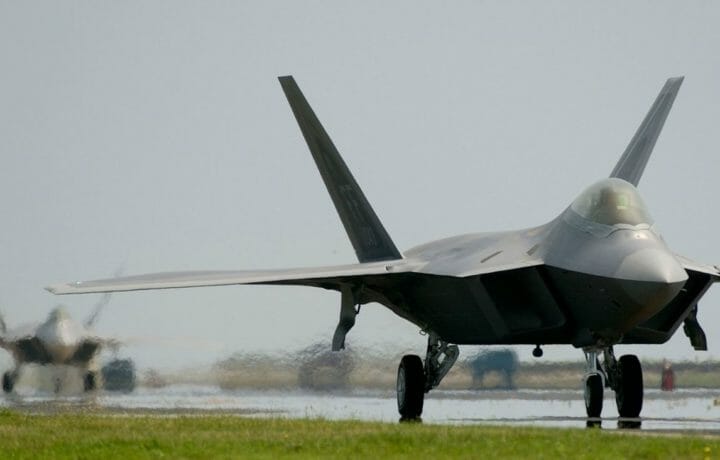The F-35 Lightning II has been in the spotlight this year – mostly due to concerns over the cost of the program. However, it hasn’t been the only fifth generation, all-weather stealth fighter aircraft built by the defense contractor for the U.S. military. The Lockheed Martin F-22 Raptor, which is still solely operated by the United States Air Force, was developed as part of the service’s Advanced Tactical Fighter (ATF) program two decades ago as an air superiority fighter that could also be capable of ground attack, electronic warfare and signal intelligence.
Cost was also an issue, and along with a lack of clear air-to-air missions, the program was vastly scaled back. Just 177 operational production aircraft were produced from a planned 750. The last F-22 was delivered by Lockheed Martin in 2012. And while the single-seat, twin-engine F-22 will eventually be replaced by the Next Generation Air Dominance (NGAD) fighter system, the Raptor has remained a vital component of the Air Force’s tactical air power.
New Beddown for the Raptor
Last month, the Air Force announced that it signed a Record of Decision approving Joint Base Langley-Eustis, VA as the future home for the F-22 Raptor Formal Training Unit (FTU). While the decision was based on a thorough environment analysis, the service will still have to await the completion of the tactical air study before solidifying timelines for the planned force structure moves.
“Consolidating the F-22 fleet at Joint Base Langley-Eustis would make use of existing force structure, which would increase aircraft availability and shorten training timelines,” the Air Combat Public Affairs office said in a statement. “This, in turn, would improve pilot production rates and readiness.”
The F-22 TFU has been previously based at Tyndall Air Force Base (AFB), FL. Due to damage from Hurricane Michael at the installation, the FTU was temporarily relocated to Eglin Air Force Base (AFB) – also in the Sunshine State – while the service determined the unit’s permanent location.
The Raptor’s deployment to Eglin has been marred by multiple mishaps.
In March 2021, a Raptor was seriously damaged during an emergency landing at Eglin AFB, while one of the fighters was lost following a training flight in May of last year. The pilot ejected safely when the aircraft from the 43rd Fighter Squadron, part of the 325th Fighter Winger crashed about 12 miles northeast of the main base.
Front Line Defense in Alaska
Despite those mishaps, the Air Force’s F-22s have proven that the aircraft is a capable air defense fighter in recent months – taking part in sorties to intercept Russian aircraft that fly just a little too close for comfort to American airspace.
In May and June of this year, F-22s from Joint Base Elmendorf-Richardson (JBER), AK have conducted intercept and escort missions of Russian Air Force Tupolev Tu-95 (NATO reporting name “Bear”) bombers. The Cold War era turbo-propeller aircraft are some of the oldest designs in active service with the Russian Air Force, but they are known to be able to fly great distances while carrying a hefty payload, which can include nuclear weapons.
The F-22s ensured the Russians didn’t overstay their welcome while conducting their operations above the neutral waters of the Baring Strait. The deployment of the Russia bombers may not have been welcomed, but it likely gave the F-22 crews some valuable operations to put their skills to the test.
JBER is home to the multi-mission 3rd Wing, which is made up of the 90th and 525th Fighter Squadrons. The base is also home to United States Air Force Reserve Command’s 477th Fighter Group, its first F-22A Raptor unit, which is responsible for recruiting, training, developing, and retaining Reserve Citizen Airmen to support retaining Reserve Citizen Airmen to support 3d Wing and Expeditionary Air Force mission requirements.
Hawaiian Island Defense
It wasn’t just the icy waters near Alaska that have seen an increased presence of Russian aircraft either. In June, armed Hawaii Air National Guard F-22s also took part in flights to monitor and track multiple Russia “Bear” bombers that flew near the Pacific island as the Russian military conducted naval and air exercises some 500 miles west of the Aloha State. It was the largest Russian naval drills in the Pacific since the end of the Cold War, and consisted of multiple warships and submarines, as well as Tu-142MZ bombers, an upgraded version of the Tu-95.
The U.S. military closely monitored the movements of the Russian flotilla and aircraft, and scrambled fighters from the 156th Fighter Wing. Two Raptors were initially launched, and then joined by a third F-22 an hour later, to track the movements of the Russian warplanes near Hawaii.
“Pacific Air Forces regularly perform air operations in airspace surrounding Hawaii. As a matter of policy, we don’t discuss tactics, techniques or procedures used by U.S. Air Force aircraft due to operational security requirements,” the Oahu-based command told the Honolulu Star-Advertiser newspaper via an email.
The F-22 Raptor will remain ready to take on the threats from Russia or other adversaries – from Virginia to Alaska and Hawaii.




